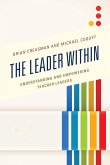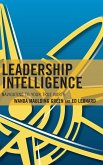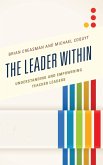Patricia Clark White, Thomas R. Harvey, Shari L. Fox
The Politically Intelligent Leader
Dealing with the Dilemmas of a High-Stakes Educational Environment
Patricia Clark White, Thomas R. Harvey, Shari L. Fox
The Politically Intelligent Leader
Dealing with the Dilemmas of a High-Stakes Educational Environment
- Broschiertes Buch
- Merkliste
- Auf die Merkliste
- Bewerten Bewerten
- Teilen
- Produkt teilen
- Produkterinnerung
- Produkterinnerung
The Politically Intelligent Leader will help leaders at all levels understand how to operate ethically during politically volatile times and how to deal with the special groups that are unique to the educational setting-elected boards, citizen groups, unions, and volunteers. And when a political crisis arises, there's some advice on how to come out of it "alive."
Andere Kunden interessierten sich auch für
![The Politically Intelligent Leader The Politically Intelligent Leader]() Patricia Clark WhiteThe Politically Intelligent Leader91,99 €
Patricia Clark WhiteThe Politically Intelligent Leader91,99 €![The Politically Intelligent Leader The Politically Intelligent Leader]() Patricia Clark WhiteThe Politically Intelligent Leader58,99 €
Patricia Clark WhiteThe Politically Intelligent Leader58,99 €![The Leader Within The Leader Within]() Brian K. CreasmanThe Leader Within46,99 €
Brian K. CreasmanThe Leader Within46,99 €![Leadership Intelligence Leadership Intelligence]() Wanda S. Maulding GreenLeadership Intelligence69,99 €
Wanda S. Maulding GreenLeadership Intelligence69,99 €![Leadership Intelligence Leadership Intelligence]() Wanda S. Maulding GreenLeadership Intelligence38,99 €
Wanda S. Maulding GreenLeadership Intelligence38,99 €![The Leader Within The Leader Within]() Brian K. CreasmanThe Leader Within85,99 €
Brian K. CreasmanThe Leader Within85,99 €![An Imperfect Leader An Imperfect Leader]() Peter L. StieplemanAn Imperfect Leader39,99 €
Peter L. StieplemanAn Imperfect Leader39,99 €-
-
-
The Politically Intelligent Leader will help leaders at all levels understand how to operate ethically during politically volatile times and how to deal with the special groups that are unique to the educational setting-elected boards, citizen groups, unions, and volunteers. And when a political crisis arises, there's some advice on how to come out of it "alive."
Hinweis: Dieser Artikel kann nur an eine deutsche Lieferadresse ausgeliefert werden.
Hinweis: Dieser Artikel kann nur an eine deutsche Lieferadresse ausgeliefert werden.
Produktdetails
- Produktdetails
- Verlag: Rowman & Littlefield Publishers
- Second Edition
- Seitenzahl: 220
- Erscheinungstermin: 14. Juli 2016
- Englisch
- Abmessung: 229mm x 152mm x 13mm
- Gewicht: 365g
- ISBN-13: 9781475828597
- ISBN-10: 1475828594
- Artikelnr.: 44674229
- Herstellerkennzeichnung
- Libri GmbH
- Europaallee 1
- 36244 Bad Hersfeld
- gpsr@libri.de
- Verlag: Rowman & Littlefield Publishers
- Second Edition
- Seitenzahl: 220
- Erscheinungstermin: 14. Juli 2016
- Englisch
- Abmessung: 229mm x 152mm x 13mm
- Gewicht: 365g
- ISBN-13: 9781475828597
- ISBN-10: 1475828594
- Artikelnr.: 44674229
- Herstellerkennzeichnung
- Libri GmbH
- Europaallee 1
- 36244 Bad Hersfeld
- gpsr@libri.de
Patricia Clark White has been superintendent of three award-winning California school districts, a national and international consultant and presenter, and an executive coach to leaders dealing with political issues. She is currently a professor and Associate Dean for the School of Education at Brandman University, overseeing the doctoral program in Organizational Leadership. Thomas R. Harvey is a professor of organizational leadership in the doctoral program at the University of La Verne. He has been the dean of the School of Organizational Management and the chairman of the Department of Educational Management for fourteen years and is the author of several books including Checklist for Change; The Practical Decision Maker; Building Teams, Building People; and The Soul of Leadership. Shari L. Fox is currently an executive coach to K-12 site and district level administrators. She is also an adjunct professor and learning group leader at the University of La Verne. She had served as school superintendent prior to retirement and now finds great joy in volunteering in her grandson Payton's classroom where she can observe firsthand the "sandbox politics" that begin at an early age.
Contents Preface Acknowledgements Part I: Developing Your Political
Intelligence 1 The Politically Intelligent Leader Defined This chapter
defines the politically intelligent leader and discusses the importance of
raising your PIQ. It explains the difference between internal and external
politics, and shoots down some of the myths about politics. 2 Blocks to
Political Intelligence Ten things that block leaders from using their
political intelligence are presented. Antidotes for each of them are
discussed. 3 Trust: The Heart of Effective Political Action Trust is
defined and explored as the core of all political strategies. Presented are
10 strategies to build trusting relationships. Part II: Using Smart
Political Strategies 4 External Strategies Nineteen external political
strategies are presented to be used by the politically intelligent leader
who is dealing with situations outside the organization. 5 Internal
Strategies Eighteen local political strategies are described, which can
enhance power and influence inside the organization. Part III:
Understanding How to Work with Political Styles 6 Understanding Your Own
Political Style Through the use of an assessment instrument, The Inventory
of Political Styles, which is included here, readers are able to analyze
their own primary, secondary, and tertiary political styles. This chapter
describes nine political styles and offers insights about how typical
behaviors connected with each style can help or hinder the individual and
the organization. 7 Working Effectively with Other Political Styles The
reader learns to analyze the political styles of other key players and to
customize a set of strategies that tend to be persuasive with those of
various styles. Part IV: Staying on an Ethical Course in Politically
Charged Situations 8 The Politically Ethical Leader Four Questions prompt
reflection on ethical decisions in a political environment. 9 Dealing with
Special Public Sector Groups This chapter examines the unique political
problems and strategies for dealing with unions and union leadership,
elected boards and councils, volunteers, advisory groups, and foundations.
10 The Machiavellian Leader If you have the misfortune of working with a
Machiavellian leader, then you need to read this chapter thoroughly. In it
we define such leadership and give you ways to cope with this style. 11
Digging Your Way Out of a Political Hole Problems are examined that arise
from digging yourself a political hole, and tips are offered on how to get
yourself out of it. Part V: Pulling It All Together 12 Practicing What We
Preach Scenarios give the reader practice in using the strategies and ideas
presented in the earlier chapters to become a politically intelligent
leader. 13 Questions: We Get Questions In this final chapter we answer the
questions posed most often in our speaking engagements. Conclusion
Appendix: Inventory of Political Styles References Index
Intelligence 1 The Politically Intelligent Leader Defined This chapter
defines the politically intelligent leader and discusses the importance of
raising your PIQ. It explains the difference between internal and external
politics, and shoots down some of the myths about politics. 2 Blocks to
Political Intelligence Ten things that block leaders from using their
political intelligence are presented. Antidotes for each of them are
discussed. 3 Trust: The Heart of Effective Political Action Trust is
defined and explored as the core of all political strategies. Presented are
10 strategies to build trusting relationships. Part II: Using Smart
Political Strategies 4 External Strategies Nineteen external political
strategies are presented to be used by the politically intelligent leader
who is dealing with situations outside the organization. 5 Internal
Strategies Eighteen local political strategies are described, which can
enhance power and influence inside the organization. Part III:
Understanding How to Work with Political Styles 6 Understanding Your Own
Political Style Through the use of an assessment instrument, The Inventory
of Political Styles, which is included here, readers are able to analyze
their own primary, secondary, and tertiary political styles. This chapter
describes nine political styles and offers insights about how typical
behaviors connected with each style can help or hinder the individual and
the organization. 7 Working Effectively with Other Political Styles The
reader learns to analyze the political styles of other key players and to
customize a set of strategies that tend to be persuasive with those of
various styles. Part IV: Staying on an Ethical Course in Politically
Charged Situations 8 The Politically Ethical Leader Four Questions prompt
reflection on ethical decisions in a political environment. 9 Dealing with
Special Public Sector Groups This chapter examines the unique political
problems and strategies for dealing with unions and union leadership,
elected boards and councils, volunteers, advisory groups, and foundations.
10 The Machiavellian Leader If you have the misfortune of working with a
Machiavellian leader, then you need to read this chapter thoroughly. In it
we define such leadership and give you ways to cope with this style. 11
Digging Your Way Out of a Political Hole Problems are examined that arise
from digging yourself a political hole, and tips are offered on how to get
yourself out of it. Part V: Pulling It All Together 12 Practicing What We
Preach Scenarios give the reader practice in using the strategies and ideas
presented in the earlier chapters to become a politically intelligent
leader. 13 Questions: We Get Questions In this final chapter we answer the
questions posed most often in our speaking engagements. Conclusion
Appendix: Inventory of Political Styles References Index
Contents Preface Acknowledgements Part I: Developing Your Political
Intelligence 1 The Politically Intelligent Leader Defined This chapter
defines the politically intelligent leader and discusses the importance of
raising your PIQ. It explains the difference between internal and external
politics, and shoots down some of the myths about politics. 2 Blocks to
Political Intelligence Ten things that block leaders from using their
political intelligence are presented. Antidotes for each of them are
discussed. 3 Trust: The Heart of Effective Political Action Trust is
defined and explored as the core of all political strategies. Presented are
10 strategies to build trusting relationships. Part II: Using Smart
Political Strategies 4 External Strategies Nineteen external political
strategies are presented to be used by the politically intelligent leader
who is dealing with situations outside the organization. 5 Internal
Strategies Eighteen local political strategies are described, which can
enhance power and influence inside the organization. Part III:
Understanding How to Work with Political Styles 6 Understanding Your Own
Political Style Through the use of an assessment instrument, The Inventory
of Political Styles, which is included here, readers are able to analyze
their own primary, secondary, and tertiary political styles. This chapter
describes nine political styles and offers insights about how typical
behaviors connected with each style can help or hinder the individual and
the organization. 7 Working Effectively with Other Political Styles The
reader learns to analyze the political styles of other key players and to
customize a set of strategies that tend to be persuasive with those of
various styles. Part IV: Staying on an Ethical Course in Politically
Charged Situations 8 The Politically Ethical Leader Four Questions prompt
reflection on ethical decisions in a political environment. 9 Dealing with
Special Public Sector Groups This chapter examines the unique political
problems and strategies for dealing with unions and union leadership,
elected boards and councils, volunteers, advisory groups, and foundations.
10 The Machiavellian Leader If you have the misfortune of working with a
Machiavellian leader, then you need to read this chapter thoroughly. In it
we define such leadership and give you ways to cope with this style. 11
Digging Your Way Out of a Political Hole Problems are examined that arise
from digging yourself a political hole, and tips are offered on how to get
yourself out of it. Part V: Pulling It All Together 12 Practicing What We
Preach Scenarios give the reader practice in using the strategies and ideas
presented in the earlier chapters to become a politically intelligent
leader. 13 Questions: We Get Questions In this final chapter we answer the
questions posed most often in our speaking engagements. Conclusion
Appendix: Inventory of Political Styles References Index
Intelligence 1 The Politically Intelligent Leader Defined This chapter
defines the politically intelligent leader and discusses the importance of
raising your PIQ. It explains the difference between internal and external
politics, and shoots down some of the myths about politics. 2 Blocks to
Political Intelligence Ten things that block leaders from using their
political intelligence are presented. Antidotes for each of them are
discussed. 3 Trust: The Heart of Effective Political Action Trust is
defined and explored as the core of all political strategies. Presented are
10 strategies to build trusting relationships. Part II: Using Smart
Political Strategies 4 External Strategies Nineteen external political
strategies are presented to be used by the politically intelligent leader
who is dealing with situations outside the organization. 5 Internal
Strategies Eighteen local political strategies are described, which can
enhance power and influence inside the organization. Part III:
Understanding How to Work with Political Styles 6 Understanding Your Own
Political Style Through the use of an assessment instrument, The Inventory
of Political Styles, which is included here, readers are able to analyze
their own primary, secondary, and tertiary political styles. This chapter
describes nine political styles and offers insights about how typical
behaviors connected with each style can help or hinder the individual and
the organization. 7 Working Effectively with Other Political Styles The
reader learns to analyze the political styles of other key players and to
customize a set of strategies that tend to be persuasive with those of
various styles. Part IV: Staying on an Ethical Course in Politically
Charged Situations 8 The Politically Ethical Leader Four Questions prompt
reflection on ethical decisions in a political environment. 9 Dealing with
Special Public Sector Groups This chapter examines the unique political
problems and strategies for dealing with unions and union leadership,
elected boards and councils, volunteers, advisory groups, and foundations.
10 The Machiavellian Leader If you have the misfortune of working with a
Machiavellian leader, then you need to read this chapter thoroughly. In it
we define such leadership and give you ways to cope with this style. 11
Digging Your Way Out of a Political Hole Problems are examined that arise
from digging yourself a political hole, and tips are offered on how to get
yourself out of it. Part V: Pulling It All Together 12 Practicing What We
Preach Scenarios give the reader practice in using the strategies and ideas
presented in the earlier chapters to become a politically intelligent
leader. 13 Questions: We Get Questions In this final chapter we answer the
questions posed most often in our speaking engagements. Conclusion
Appendix: Inventory of Political Styles References Index








